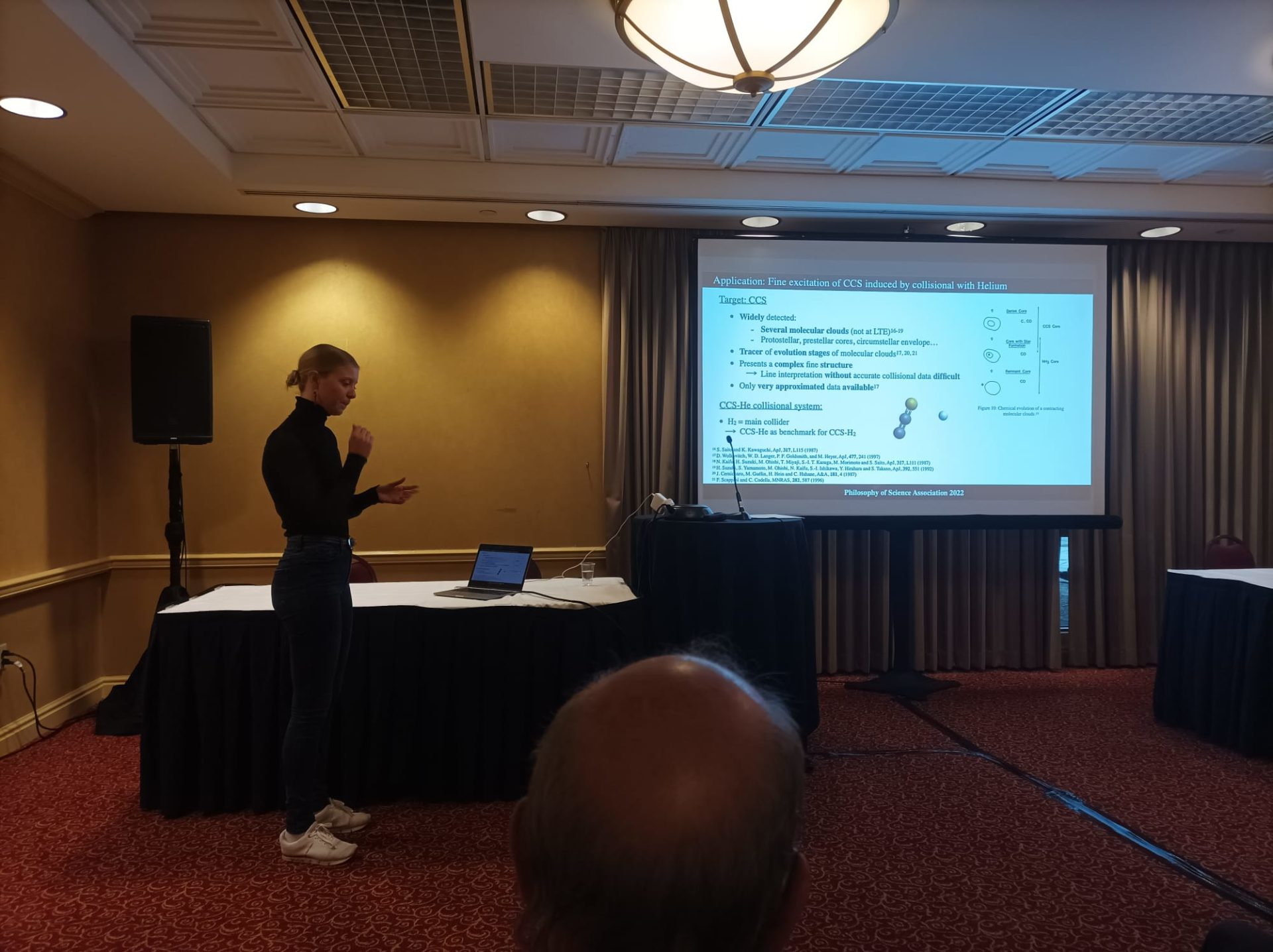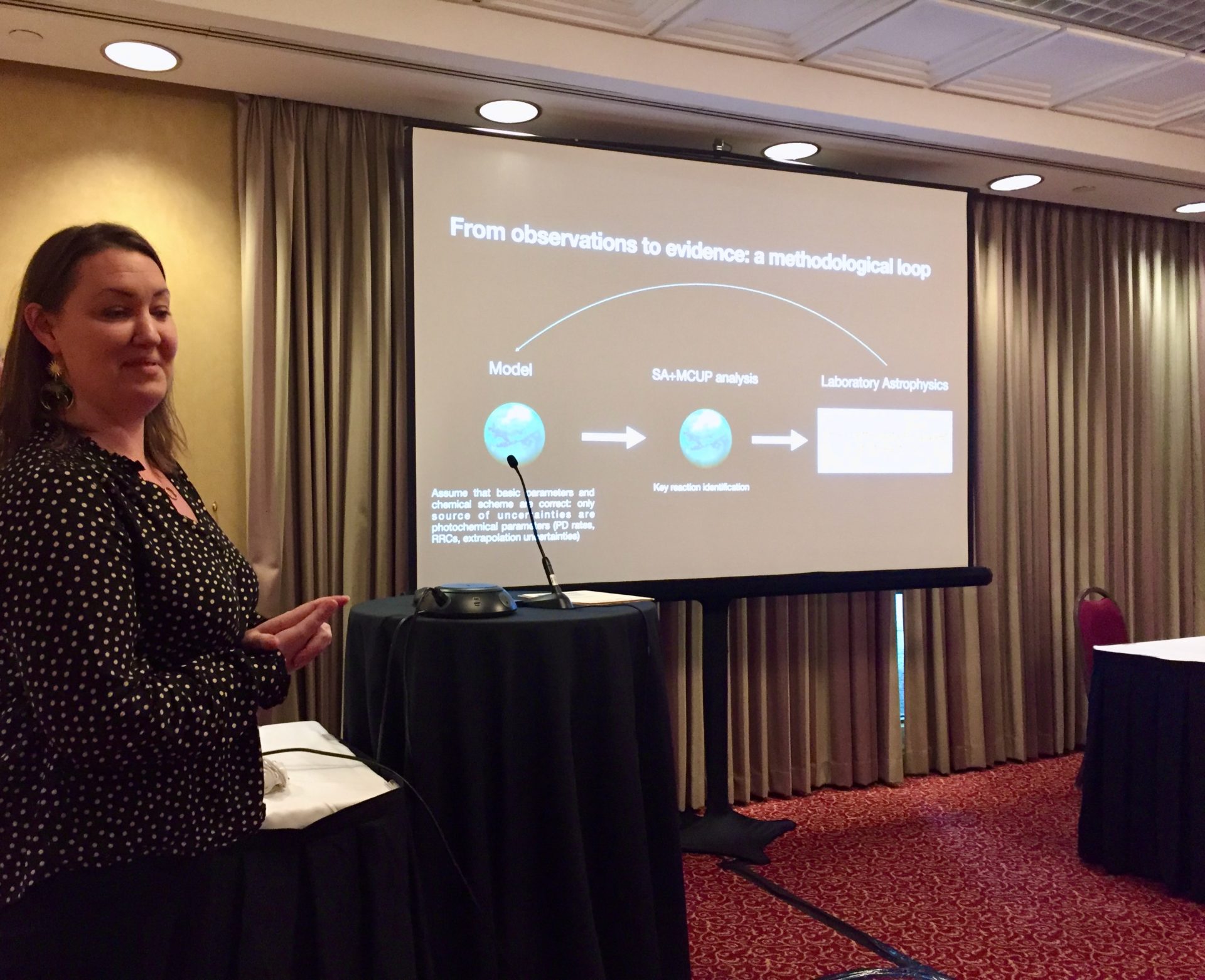by Marie Gueguen & François Lique & Amélie Godard Palluet, on
Presentation of the meeting

The role of PSA is to promote research, teaching, and free discussion of issues in the philosophy of science from diverse standpoints since 1933.
Symposium were organized to discuss challenges of climate sciences, machine learning, quantum mechanics, social sciences etc.
M. Gueguen was selected to organize her own symposium entitled "Epistemic Iteration, Validation and Model Evaluation in Astrochemistry". She invited F. Lique and A. Godard Palluet to present the different methodologies used in astrochemistry and the uncertainties that can arise from them.
Epistemic Iteration, Validation and Model Evaluation in Astrochemistry - Symposium organized by M. Gueguen
Iterative testing is essential to explore complex phenomena, especially in computationally intensive fields, where no analytical solutions or reliable observations can guide the models' development. Hence, its success cannot be justified by reference to a correct solution, but only by its capacity to self-correct despite initial imperfect ingredients. How can then scientists safeguards this autonomy while ensuring its productive interplay with observation, guaranteeing that models remain informed by and evaluated against new empirical findings? We analyse how insights from astrochemistry, an emerging field with steady influxes of new observations, whose models are developed iteratively, apply to other fields.
The source of uncertainties in astrochemical modelling - F. Lique

Astrochemistry is "the study of the formation, destruction and excitation of molecules in astronomical environments and their influence on the structure, dynamics and evolution of astronomical objects” as stated by Alexander Dalgarno the pioneer of this field. Astrochemistry comprises observations, theory and experiments aimed at interpreting molecular emission patterns in space. It is, by definition, a multidisciplinary field of research where the sources of uncertainties are numerous. In this talk, I will present the scientific procedure in astrochemistry that goes from the calculations and /or the measurement of molecular data to the determination of the physical conditions lying in astrophysical media. For each step, I will detail the possible source of uncertainties and discuss the global impact of these uncertainties in the knowledge of the chemical complexity in space and of the formation of stars and planets. I will illustrate my presentation with recent examples demonstrating that reducing the uncertainties could lead to significant improvement of our knowledge of astrophysical media.
Collisional excitation of interstellar molecules: methodology and uncertainties - A. Godard Palluet, F. Lique
The astrophysical media are extremely (if not impossible) difficult to probe. Their chemical characterization can only be done through the analysis of the emission spectra registered by telescopes. Since the lines composing the spectra represent the emission energy between quantified and variously populated energy levels of a specific chemical species, it is often said that the emission spectra captured by telescopes contains the chemical signature of the media. Transition within these levels can occur by absorption/emission of a photon or through a collisional energy transfer.
In order to model the spectra, the efficiency of these processes needs to be evaluated. In astrochemistry, one of the challenging goal is thus to compute accurate collisional data such as the excitation rate coefficients induced by the dominant astrophysical species (He, H, H2, e- ), from which astrophysicists can then deduce energy levels population and thus, derive the abundance of species and model the spectra.
The problem, however, is that an exact quantum calculations of these rates is not reachable in terms of computational time and memory. Therefore, the obtention of realistic rate coefficients for unstudied molecular system requires the setting of a correct methodology, which will include multiple approximations from which several uncertainties of different nature will arise. The standard methodology for the obtention of rate coefficients proceed in two steps. First, a quantum chemistry method is used to span the interaction potential between the colliders and obtain the so-called potential energy surface (PES) of the system. Then, the dynamics of the nuclei are studied on the computed surface.
Through the procedure, some validation can be done, in order to ensure the validity of the rates: the PES can be validated through the computation of spectroscopic data based on this surface that can be compared to experimental measurements. The collisional data from which rate coefficients arise can be also validated through the comparison between computed and measured pressure broadening coefficients. Such validation, however, implies that spectroscopic data are available for the molecular system under consideration, which is not always the case.
This talk will start by a presentation of the methodology developed to obtain highly accurate rate coefficients. Then, its application to the CO2-He and CCS-He collisional system will be presented. The CO2-He system was well studied during the last decades, from both a theoretical and an experimental point of view, and can as such be used as a benchmark system for the validation of our methodology. Afterwards, I will show how I extrapolated this methodology to the CCS-He system, for which no rate coefficients exist.
Indeed, the CCS molecule and its 13CCS and C13CS isotopologues have been detected in interstellar clouds. But the spectra lines of 13C-isotopologues have significant differences in their intensities when they should be similar given the current astrochemical models used by astronomers. Can we resolve this anomaly through the computation of accurate rate cofficients? The intensity difference could be explained away if the rate coefficients for both isotopologues are different by the same factor that the spectroscopic lines. If the rate coefficients do not explain this difference, does this mean that the chemical model used to determine the respective abundancies of these isotopologues somewhat incorrect?

Extending the loop: model evaluation and discordances in astrochemistry

In this talk, I present different strategies for evaluating the adequacy of a given model in context of high uncertainties, all based on the idea of iterative coherence testing, i.e., a methodology that anchors the improvement of the models accuracy in an iterative process of solving the discrepancies between the model’s predictions and observations.
Based on Le Quéré (2006), we consider three different phases of the development of a model and how iterative conference testing, or “the closing the loop” methodology in G. Smith’s terms, can guide decisions for improving the model for each one of these phases. I argue that iterative testing serves a different purpose and is connected to a different evaluation strategy at each phase of the development of a model, from the adoption of a initial model known to be imperfect to a mature model ready to be confronted to observations. I will illustrate the merits and pitfalls of such an account of iterative testing and model evaluation based on the example of the photochemical models of Titan’s atmosphere developed over the last two decades.
Models of Titan’s atmosphere have roughly followed two very different paths: either they have started with a complex chemical model but simplified astrophysical constraints, or with a complex description of the astrophysical conditions but a simplified chemistry. Both, however, failed to reproduce observations, although uncertainties attached to observations made the discordance not so worrying, until the observations of the Cassini-Huygens’ mission were released in 2007. The latter showed that the discrepancies were not dampened, but on the contrary worsen by improved observations: the uncertainty attached to the model were shown to be higher than those related to observations, rendering the comparison between observations and models impossible to interpret.
This case has led to an impressive surge of creativity from the astrochemists, who have exploited this opportunity to develop innovative iterative tools designed to enrich and develop their photochemical network to the point where a discordance between their chemical models and the Cassini’s observations could finally be significantly interpreted.